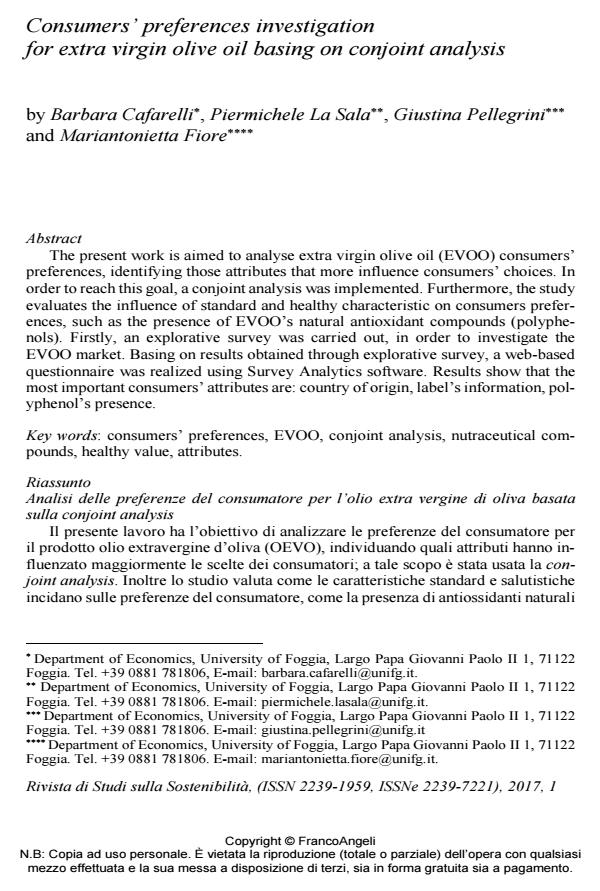Consumers’ preferences investigation for extra virgin olive oil basing on conjoint analysis
Journal title RIVISTA DI STUDI SULLA SOSTENIBILITA'
Author/s Barbara Cafarelli, Piermichele La Sala, Giustina Pellegrini, Mariantonietta Fiore
Publishing Year 2017 Issue 2017/1
Language English Pages 16 P. 203-218 File size 218 KB
DOI 10.3280/RISS2017-001013
DOI is like a bar code for intellectual property: to have more infomation
click here
Below, you can see the article first page
If you want to buy this article in PDF format, you can do it, following the instructions to buy download credits

FrancoAngeli is member of Publishers International Linking Association, Inc (PILA), a not-for-profit association which run the CrossRef service enabling links to and from online scholarly content.
The present work is aimed to analyse extra virgin olive oil (EVOO) consumers’ preferences, identifying those attributes that more influence consumers’ choices. In order to reach this goal, a conjoint analysis was implemented. Furthermore, the study evaluates the influence of standard and healthy characteristic on consumers preferences, such as the presence of EVOO’s natural antioxidant compounds (polyphenols). Firstly, an explorative survey was carried out, in order to investigate the EVOO market. Basing on results obtained through explorative survey, a web-based questionnaire was realized using Survey Analytics software. Results show that the most important consumers’ attributes are: country of origin, label’s information, polyphenol’s presence.
Keywords: Consumers’ preferences, EVOO, conjoint analysis, nutraceutical compounds, healthy value, attributes.
- EU quality labels in the Italian olive oil market: How much overlap is there between geographical indication and organic production? Luigi Roselli, Giacomo Giannoccaro, Domenico Carlucci, Bernardo De Gennaro, in Journal of Food Products Marketing /2018 pp.784
DOI: 10.1080/10454446.2017.1413473 - An International Survey on Olive Oils Quality and Traceability: Opinions from the Involved Actors Ramón Aparicio-Ruiz, Noelia Tena, Diego L. García-González, in Foods /2022 pp.1045
DOI: 10.3390/foods11071045 - Sustainability Certification, a New Path of Value Creation in the Olive Oil Sector: The ITALIAN Case Study Luca Lombardo, Camilla Farolfi, Ettore Capri, in Foods /2021 pp.501
DOI: 10.3390/foods10030501 - Young consumers' perception of food safety and their trust in official food control agencies Justyna Franc-Dąbrowska, Irena Ozimek, Iwona Pomianek, Joanna Rakowska, in British Food Journal /2021 pp.2693
DOI: 10.1108/BFJ-11-2020-0992 - The Willingness to Pay in the Food Sector. Testing the Hypothesis of Consumer Preferences for Some Made in Italy Products Lucio Cappelli, Fabrizio D’Ascenzo, Maria Felice Arezzo, Roberto Ruggieri, Irina Gorelova, in Sustainability /2020 pp.6275
DOI: 10.3390/su12156275
Barbara Cafarelli, Piermichele La Sala, Giustina Pellegrini, Mariantonietta Fiore, Consumers’ preferences investigation for extra virgin olive oil basing on conjoint analysis in "RIVISTA DI STUDI SULLA SOSTENIBILITA'" 1/2017, pp 203-218, DOI: 10.3280/RISS2017-001013